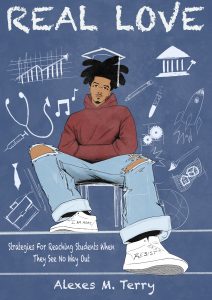I usually teach Advanced Placement and Dual Credit (AP/DC) English at the high school and college levels. As such I have attended staff development meetings where, at some point, the subject of novels to teach comes up. Suddenly, it’s a room of avid readers talking about the books they love and want to share with their students. The list of books shared rarely, if ever, included black writers. As an African American teacher, I notice this lack every single time. But this is not a tirade about the racism, sexism, and colonialism inherent in both the American or British literary canons.
During these meetings, I am often the only black person present and find their lack of diversity annoying and insulting. I have never failed to point this out and these teachers would all look vaguely uncomfortable, then immediately claim a love for Morrison or Wright, or ask for a recommendation. These men and women have the same basic education I do, and the same access to texts by black authors, but don’t see it as their job to find texts by people of color for their students. This lack of concern was so deeply ingrained that they didn’t even perceive it as a problem. Many have an absolute omission of diverse works in their reading lists and don’t care.
I created this list, not for them, but for me. I wanted to have a list at hand of texts I loved by African American writers I admire and whose work I find superior to many in the American and British canons. These are books that challenge both the stereotypes about black life and provide a good jumping off point for exploring African American literature. All are novels; many have been made into movies; several deserve more attention than they’re getting right now. And, finally, of course, the books are interesting and insightful about African American life across approximately 60 years. I wouldn’t recommend them otherwise.
So, without further ado, here is my list of seven African American novels you and your students need to read:
Black No More, George Schuyler
George Schuyler was a prominent African American author and journalist at the turn of the twentieth century. He famously argued in “The Negro Art Hokum” that there was no such thing as a “Negro artist”–only American artists of Negro descent. This attitude, coupled with his embrace of socialism, led to several significant disagreements with W. E. B. Du Bois.
His most significant literary achievement was the satirical novel, Black No More, which examines a United States where a medical “procedure” makes it possible for black people to become white. Chaos ensues. The novel is wonderfully written, with biting wit, interesting characters, and a subtle message that will not confuse the reader. It also contains some charming characterizations of famous African American cultural icons, such as Du Bois, Madam C. J. Walker, and Marcus Garvey.
There is some mild profanity and violence, as well as alcohol consumption, mild profanity, and jazz clubs. The novel is appropriate for grades 9 and above.
Toni Morrison won a Nobel Prize for her writing. Her novels are entrancing and challenging reads. The woman KNOWS how to use language. She has a long and celebrated oeuvre and any one of them will enhance your literary knowledge and interpretative skills. But this one…this one right here will break your heart, make you furious, and force you to recognize that the world treats little black girls very, very different than all the other little girls out there.
Pecola Breedlove is eleven years old, poor, dark-skinned, and unloved. She prays that her eyes will turn blue so that people will think her beautiful and thus worthy of love. Just let that sink in right there. The novel showcases Morrison’s masterful use of language and is a good introduction into her works. This was her first published work and a masterpiece of American literature. I also recommend Song of Solomon and A Mercy. These are two of my favorites.
This novel contains descriptions of domestic violence and incest, though it does not describe either of these events in detail. There is also a brief description of a sexual nature but again no detail is given. It is appropriate for grades 9 and above.
The Women of Brewster Place, Gloria Naylor
If you’ve seen the TV movie starring Oprah Winfrey, then you don’t know this novel. There is a depth and beauty to this novel about the lives of six black women. These women, through a series of unfortunate events and questionable decisions, end up in living in a tenement, on a dead-end street in the ghetto. Each woman’s story is given a chapter of it’s own so that you can see and understand the devolution of their lives leading to this place. This is also the only novel recommend that is set in the relatively proximate past – the 1970s.
The novel is also unusual for providing a positive representation of a lesbian relationship.
This novel contains violence, child neglect, alcohol abuse, derogatory language, and sexual assault. The ending is gut-wrenching and brutal. It is appropriate for grades 11-12 and college students only. If teaching this text, it is absolutely imperative that there are prior discussions about scenes in the novel and accommodations made for potential triggering events.
This one is hard to provide a short description for. This novel follows the last days of twenty-year-old Bigger Thomas, a young black man living in poverty on Chicago’s South Side in 1930s. Wright examines the impact of racism, poverty, and systemic oppression upon the psyche of young American men of African descent. The novel was intended as a warning to white America that it was responsible for the “monsters” that these men might become and that racism is far more crippling than they might ever understand. This novel is brutal, both in its depiction of violence and its attack on systemic racism and the hypocrisy of the white elite.
This novel contains racial and gender violence, rape, profanity, racial slurs, cursing, and alcohol abuse. It is appropriate for grades 11-12 and college students only. If teaching this text, it is absolutely imperative that there are prior discussions about scenes in the novel and accommodations made for potential triggering events.
The Color Purple, Alice Walker
Another novel that inspired a movie. The movie is fantastic and the book is even better. With The Color Purple, Walker won a Pulitzer Prize for Fiction in 1982. Walker’s prose and characters are well worth your time; the language is beautiful and poetic and the characters highlight not only the strength of black women but the community and love which helps them maintain that strength. It’s nearly impossible to give a synopsis of this novel without giving away significant plot points. Just trust me on this: read this book!
This novel contains racial and domestic violence, as well as sexual content. It is not appropriate for ages under sixteen. If teaching this text, it is absolutely imperative that there are prior discussions about scenes in the novel and accommodations made for potential triggering events.
I love this novel. It makes me happy. It’s a totally captivating tale of the ways that sexism, racism, and poverty can, and will, destroy even the most optimistic person. Lutie Johnson moves with her young son into Harlem in the 1940s; there they struggle to survive amidst the violence, poverty, and racism of the period. One of the best things about this novel is the way that Harlem seems as much a character in this novel as any of the people. The opening lines alone are a great introduction to Petry’s style and how she views this place and its impact upon people living there.
Petry’s work doesn’t flinch away from the harsh realities of life for black women in 1930-40s New York, and her novel easily serves as a counterpoint to the happy-go-lucky movie depictions of white American life of the same time period. Petry’s Harlem is full of jazz and menace, hope and broken dreams. But don’t be mistaken, this is pure social critique. Petry clearly illustrates the frustration of black women and men as they continually strive to better themselves only to be undermined by both white people and the systemic racism built into the very fabric of America.
This novel contains some racial, sexual, and domestic violence. There is also a discussion about child abandonment and theft. It is appropriate for grades 9 and above. It is important that accommodations are made for potential triggering events.
The Autobiography of Malcolm X, Alex Haley
So many people quote Malcolm X but don’t really understand who he was or why he was motivated to speak out. Learn his story from his own mouth, not just the highly prejudiced depictions of him that were created through selective filtering of his life. The man was so much more than “…by any means necessary!” and much of his beliefs and the quotes you hear attributed to him have been misinterpreted or taken out of context. He was complex and brilliant, and a true believer in his faith. He was also a highly principled man, which is likely what got him killed. You don’t know Malcolm. Take the time to learn.
This novel contains drug use, derogatory language, racial slurs, and violence. It is a work of nonfiction and is appropriate for grades 9 and above.
This list isn’t exhaustive and is, in fact, decidedly short of 21st century Black* writers. That’s another list altogether. This is just a primer for getting started within the African American literary canon. These novels can be used to successfully build a reading library of texts that discuss the impact of race and gender within American culture and tell some great stories as well.
*The use of “Black” is deliberate as there are many amazing international authors–men and women of the African diaspora–from South America to London to Nigeria.
Rosalyn K. Mack has over twelve years of experience teaching both secondary and post-secondary English and Literature. She holds a Bachelor’s degree in English, and two Master’s degrees in Literature and Humanities, specializing in modern American literature, women writers, and African American history. She currently lives in Mesquite, TX and teaches composition and rhetoric locally. She loves reading, travel, history podcasts, and very large dogs.




